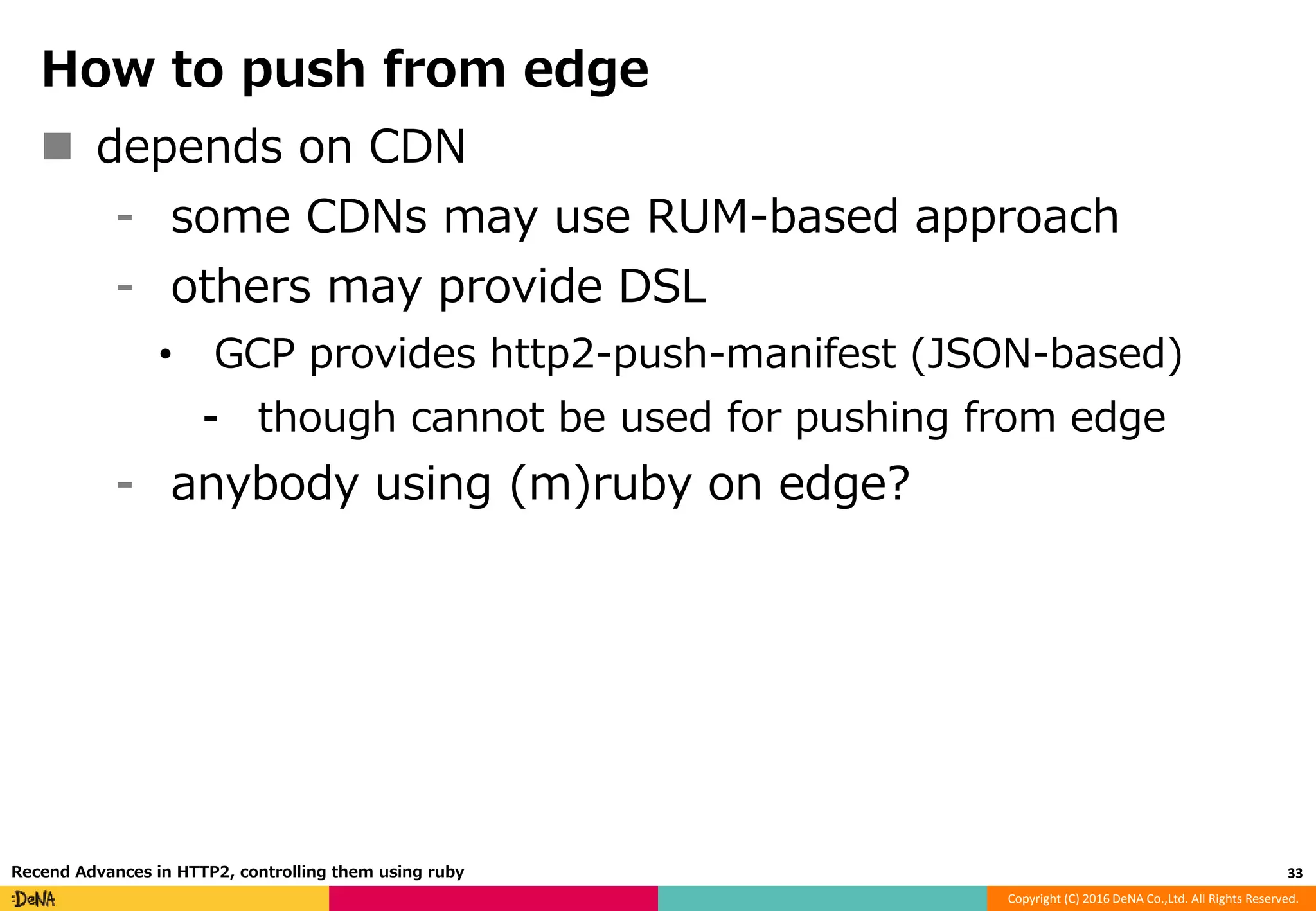The document discusses advancements in HTTP/2 and its advantages over HTTP/1, particularly highlighting its capabilities to reduce latency through features like multiplexing, prioritization, and header compression. It emphasizes the importance of effective server configurations and cache-aware push mechanisms to optimize performance while noting potential pitfalls such as head-of-line blocking. The author, Kazuho Oku, showcases his work in HTTP/2 implementations and suggests that H2O is a leading server for HTTP/2 performance.




























![Copyright (C) 2016 DeNA Co.,Ltd. All Rights Reserved.
How to push while processing request
configure your H2 server
⁃ in case of H2O:
mruby.handler: |
Proc.new do |env|
push_paths = []
if /(/|.html)$/.match(env["PATH_INFO"])
push_paths << "/style.css”
...
end
[399, push_paths.empty? ? {} : {"link" =>
push_paths.map{|p| "<#{p}>; rel=preload"}.join("n")}, []]
end
file.dir: /path/to/doc-root
29Recend Advances in HTTP2, controlling them using ruby](https://image.slidesharecdn.com/http2-rubykaigi20160910-upload-160910060854/75/Recent-Advances-in-HTTP-controlling-them-using-ruby-29-2048.jpg)

![Copyright (C) 2016 DeNA Co.,Ltd. All Rights Reserved.
... and more
Access Control
mruby.handler: |
acl {
allow { addr == "127.0.0.1" }
deny {
user_agent.match(/curl/i) && !addr.start_with?("192.168.")
}
respond(503, {}, ["Service Unavailable"]) {
addr == malicious_ip
}
redirect("https://example.com/", 301) {
path =~ /moved/
}
use Htpasswd.new("/path/to/.htpasswd", "realm") {
path.start_with?("/admin")
}
}
31Recend Advances in HTTP2, controlling them using ruby](https://image.slidesharecdn.com/http2-rubykaigi20160910-upload-160910060854/75/Recent-Advances-in-HTTP-controlling-them-using-ruby-31-2048.jpg)
![Copyright (C) 2016 DeNA Co.,Ltd. All Rights Reserved.
... and more
fast IPv4 address matching using Trie4
mruby.handler: |
require "trie_addr.rb"
trie = TrieAddr.new.add([
"192.168.0.0/16", "172.16.0.0/12", ...]
)
acl {
allow { trie.match?(addr) }
deny
}
4: http://dsas.blog.klab.org/archives/51293338.html
32Recend Advances in HTTP2, controlling them using ruby](https://image.slidesharecdn.com/http2-rubykaigi20160910-upload-160910060854/75/Recent-Advances-in-HTTP-controlling-them-using-ruby-32-2048.jpg)




